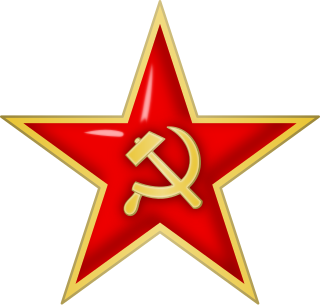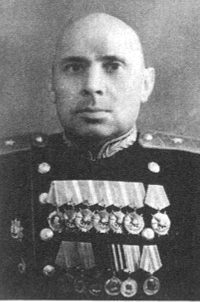The 4th Army was a Soviet field army of World War II that served on the Eastern front of World War II and in the Caucasus during the Cold War. It was disbanded after the fall of the Soviet Union, with its divisions being withdrawn to Russia and disbanded.
The 52nd Rifle Division was an infantry division of the Red Army during the Russian Civil War, the interwar period, World War II, and the Cold War, formed once during the Russian Civil War and three times during the existence of the Soviet Union.
The 2nd Baltic Front was a major formation of the Red Army during the Second World War.
The 6th Rifle Division was an infantry division of the Soviet Union's Red Army. Formed multiple times, it participated in several battles, most notably the Soviet westward offensive of 1918–1919, the Estonian War of Independence, the Polish–Soviet War. In the latter war, the division was severely defeated by Polish troops. The division's first formation was awarded the Order of the Red Banner twice and the Order of Suvorov 2nd class for its valor in combat. In November 1945, the division was disbanded. It was briefly reformed in 1955 but disbanded again in 1957.

The 10th Army of the Soviet Union's Red Army was a field army active from 1939 to 1944.
The 1st Mechanized Corps was a mechanized corps of the Red Army during World War II that formed twice.

The 10th Guards Army was a Soviet Guards formation which fought against Germany during World War II under the command of several generals. Formed in 1943, the army fought under various headquarters and ended the war besieging cut-off German forces in Latvia. The 10th Guards Army was disbanded in 1948.
The 342nd Rifle Division began forming in September 1941, as a standard Red Army rifle division, in the Saratov oblast. It arrived at the front southwest of Moscow in December, in time to take part in the winter counteroffensive. During most of 1942 and into 1943 the division served in primarily defensive roles in 61st Army along the northern face of the German-held salient around Oryol. Following the Soviet victory at Kursk the 342nd took part in the operation that eliminated that salient, and then in the further offensives that liberated Bryansk and pushed on towards Smolensk and the Dniepr River. During these tactical-level actions the division distinguished itself sufficiently to be re-designated as the 121st Guards Rifle Division, one of the last Guards divisions to be formed before the postwar period. In November 1944, a new 342nd was formed in the Far East, and saw action against Japanese forces in northern Manchuria, assaulting across the Sungach river during the Soviet invasion of that region. Well after the war this formation was re-designated and became the 33rd Motor Rifle Division.
The 11th Tank Division was a Soviet tank division initially formed in 1940 at Tiraspol and destroyed in 1941; it was then formed as a tank corps in May 1942. This unit was subsequently reorganized as the second formation of the 11th Tank Division in 1945.

The 5th Shock Army was a Red Army field army of World War II. The army was formed on 9 December 1942 by redesignating the 10th Reserve Army. The army was formed two times prior to this with neither formation lasting more than a month before being redesignated.
The 105th Guards Airborne Division was an airborne division of the Soviet Airborne Troops.
The 16th Guards Tank Division was a tank division of the Soviet Army and later the Russian Ground Forces.
The 260th Rifle Division was an infantry division of the Red Army during World War II, formed twice.
The 374th Rifle Division was raised in 1941 as an infantry division of the Red Army, and served for the duration of the Great Patriotic War in that role. It began forming in August 1941 in the Siberian Military District. It joined the fighting front in December with the new 59th Army along the Volkhov River and it continued to serve in the fighting near Leningrad until early 1944. The dismal fighting on this front gave little opportunity for a unit to distinguish itself, and the division did not finally earn a battle honor until late January 1944, during the Leningrad–Novgorod Offensive. It continued to serve in the summer and autumn offensive through the Baltic States, becoming so reduced in strength that its remaining infantry was consolidated into a single understrength regiment which nevertheless won a battle honor in the liberation of Riga. The 374th ended the war in Latvia, helping to contain and reduce the German forces trapped in the Courland Pocket, and was disbanded shortly thereafter.
The 41st Guards Rifle Division was formed as an elite infantry division of the Red Army in August 1942, based on the 1st formation of the 10th Airborne Corps, and served in that role until after the end of the Great Patriotic War. It was the last of a series of ten Guards rifle divisions formed from airborne corps during the spring and summer of 1942. It was briefly assigned to the 1st Guards Army in Stalingrad Front, then to the 24th Army in Don Front, and suffered heavy casualties north of Stalingrad before being withdrawn to the Reserve of the Supreme High Command for a substantial rebuilding. Returning to 1st Guards Army in Southwestern Front in November it took part in Operation Little Saturn as part of 4th Guards Rifle Corps and then advanced into the Donbas where it was caught up in the German counteroffensive in the spring of 1943. During the summer and fall the division fought its way through eastern Ukraine as part of the 6th, and later the 57th Army under several corps commands. It would remain in the southern part of the front for the duration of the war. By February 1944 it was in the 7th Guards Army and took part in the battle for the Korsun Pocket, winning its first battle honor in the process. Shortly after it was transferred to the 4th Guards Army, where it would remain for the duration, still moving through several corps headquarters. The 41st Guards saw limited service in the first Jassy-Kishinev offensive in the spring, but considerably more in August's second offensive and several of its subunits received battle honors or decorations. The division itself won a second honorific during the offensive into Hungary in January 1945 and was later decorated for its role in the capture of Budapest. After the fall of Vienna in April it did garrison duty in the city for a short time before being directed west into lower Austria where it linked up with U.S. forces in the last days of the war. In October, while still in Austria, it was converted to the 18th Guards Mechanized Division.
The 46th Guards Rifle Division was formed as an elite infantry division of the Red Army in October 1942, based on the 2nd formation of the 174th Rifle Division, and served in that role until after the end of the Great Patriotic War. It was in the 6th Army of Voronezh Front when it won its Guards title, but was immediately moved to the Reserve of the Supreme High Command for rebuilding, where it was soon assigned to the 5th Guards Rifle Corps. In mid-November it moved with its Corps to join the 3rd Shock Army in Kalinin Front and played a leading role in the Battle of Velikiye Luki, both in the encirclement of the German garrison of that city and then in fighting off several relief attempts. It remained in the area through the spring and summer of 1943 before taking part in the breakthrough battle at Nevel and the subsequent operations to expand the salient and pinch off the German positions that 3rd Shock had partly surrounded. In June 1944 the 46th Guards was reassigned to the 6th Guards Army of 1st Baltic Front in preparation for Operation Bagration and made a spectacular advance into Luthuania through the "Baltic Gap" between Army Groups Center and North. The division would continue to serve in the Baltic states in 6th Guards for the duration of the war, winning the Order of the Red Banner in the process and ending on the Baltic coast in 22nd Guards Rifle Corps helping to contain the German forces trapped in the Courland Pocket. Despite a creditable record of service the division was disbanded shortly after the end of hostilities.

Iosif Ivanovich Popov was a Soviet Army major general who held corps command during World War II.
The 119th Guards Rifle Division was formed as an elite infantry division of the Red Army in September 1943, based on the 11th Guards Naval Rifle Brigade and the 15th Guards Naval Rifle Brigade and was one of a small series of Guards divisions formed on a similar basis. Although the two brigades had distinguished themselves in the fighting south of Stalingrad as part of 64th Army they were moved to Northwestern Front in the spring of 1943 before being reorganized. After serving briefly in 22nd Army the division was moved to reinforce the 3rd Shock Army within the large salient that Army had created behind German lines after a breakthrough at Nevel in October. In the following months it fought both to expand the salient and defend it against German counterattacks in a highly complex situation. In January 1944 it was transferred to the 7th Guards Rifle Corps of 10th Guards Army, still in the Nevel region, after which it advanced toward the Panther Line south of Lake Peipus. During operations in the Baltic states that summer and autumn the 119th Guards was awarded both a battle honor and the Order of the Red Banner for its operations in Latvia. In March 1945 it joined the Kurland Group of Forces of Leningrad Front on the Baltic coast containing the German forces encircled in northwest Latvia. Following the German surrender it was moved to Estonia where it was disbanded in 1946.
The 235th Rifle Division was an infantry division of the Red Army, originally formed in the months just before the start of the German invasion, based on the shtat of September 13, 1939. As part of the 41st Rifle Corps it was soon sent to Northwestern Front to defend the distant approaches to Leningrad. Along with its Corps the division became part of the Luga Operational Group. After Novgorod was captured the Luga Group was largely encircled and had to fight its way north toward the city, suffering considerable losses in the process. The losses to the 235th were greater than those of some others and after officially carrying on in the reserves of Leningrad Front for some time the division was officially disbanded in late December.
The 28th Tank Division was an armored division of the Red Army, created during the prewar buildup of forces in the Baltic Special Military District, based on a light tank brigade and a motorized rifle brigade, and fought against German Army Group North during the first months of Operation Barbarossa. It was initially under command of the 12th Mechanized Corps of 8th Army. It was noteworthy for being the first wartime command of Ivan Chernyakhovskii, who went on to lead the 3rd Belorussian Front. The division's tank regiments were largely destroyed in the first battles, but not without inflicting losses themselves, after which the remnants fell back through Latvia and Estonia, receiving enough reinforcements and replacements to remain combat-effective. It served well at Novgorod and in the early fighting around Demyansk, as part of 27th Army, but in November the Stavka ordered it to be converted to the 241st Rifle Division.



